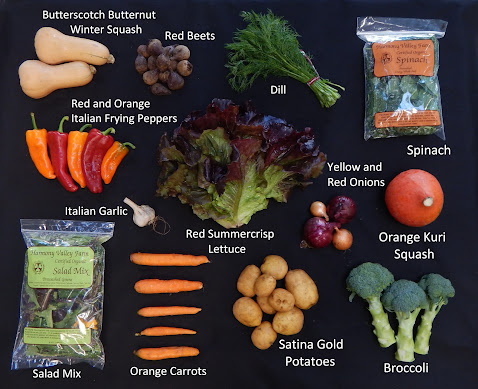What's In The Box
Italian Garlic: We’ve started cracking garlic in preparation for planting our 2025 crop! Garlic is an investment we gamble on every year, but it’s also an investment in our health when we eat it! Adding a little to your meals each day is the most affordable health insurance!
Yellow and Red Onions: The sulfur compounds in onions are what give them their pungency and also make us cry sometimes. As the plant is growing, these compounds are part of the plant’s defense system to protect them from disease and pests. When we consume them, they work as powerful antioxidants that support our health throughout our body systems. We consider onions to be a foundational part of our diets, both for their health benefits as well as the base flavor they contribute!
Orange & Red Italian Frying Peppers: With low temperatures forecasted for early next week, the end of pepper season is upon us. We think you’ll find this week’s frying peppers to be sweet and delicious as they are at their peak of ripeness! If you have one that is a little soft, it’s likely still good. The pepper just gets a little soft as it ripens. If you aren’t able to eat your peppers within a week, pop them in the freezer and use them later as a pizza topping, added to soups and stews, stir-fry or scrambled eggs.
Salad Mix: We are nearing the end of our salad mix for the season. Our fall crops came in a few weeks ahead of schedule with the warm fall. Enjoy with a light vinaigrette, shredded carrots, and thinly sliced peppers for a quick salad. Add protein such as chicken or salmon if you’d like to turn it into a main dish!
Spinach: We are nearing the end of our baby spinach for this fall as well. Use this week’s spinach as the base for a salad or toss it into pasta dishes or soups and wilt it down.
Red Summercrisp Lettuce OR Green Boston Lettuce OR Green Savoy Cabbage: Regardless of the selection in your box, wash the leaves well and either pat dry or dry them in a spinner before storing or using.
Broccoli: Our fall broccoli extravaganza continues! We encourage you to eat both the florets on top as well as the stalks and stems. Check out this week’s recipe suggestions below for some ways to put this week’s broccoli to use.
Orange Carrots: Going into the fall, rest assured we have a strong supply of sweet, delicious carrots! This staple vegetable is a great addition to roasted vegetable blends, soups and stews, cold-weather salads, as well as baked goods and desserts!
Satina Gold Potatoes: This week’s potatoes have gold skin and gold flesh. They are a moist, waxy potato that is best for pan-frying or roasting, but they may also be simply steamed or boiled. Some of the potatoes may have some slight blemishes or brown spots. As we sorted them, we realized these blemishes are usually just affecting a small amount of the surface and the remainder of the potato is just fine. So we ask that you just cut away any spots with a paring knife and enjoy the remaining 95% of the potato!
Butterscotch Butternut Winter Squash: This a small variety of butternut known to be sweet and flavorful…. hence the name. Enjoy this small squash simply prepared. Cut them in half lengthwise and bake. Serve with salt, pepper, and a pat of butter…for the main meal or dessert!
Orange Kuri Squash or Sugar Dumpling Squash: Orange Kuri squash is bright orange and round. The flesh is deep orange and rich, perfect for baked goods, soup, and curry dishes. Sugar dumpling squash is a creamy yellow color with green stripes and markings. The flesh is light yellow and sweet. Given their small size, they too can serve as a personal size serving.
Red Beets: A simple way to enjoy your beets is to roast them. You can roast them whole with the skin on or peel them first and cut into chunks and toss with oil. Once roasted, you can use them as a topping for salads, mix them in with quinoa or other grains, or just eat them as a roasted beet!
Dill: Before winter sets in we wanted to share one more bunch of fresh dill with you! Pair it with this week’s potatoes, beets, or carrots. Check out the featured recipe and recipe suggestions for inspiration!
BONUS: Purple or Yellow Cauliflower or Broccoli Romanesco: We are nearly finished with these crops for the season. The harvest is dwindling, and the remaining heads are on the small side. Your box may contain a portion, but if not, we have added extra broccoli.
Recipe Suggestions & Inspiration For This Week’s Box Contents
Caramelized Carrot Tart with Fresh Dill
Broccoli & Wild Rice Casserole
Teriyaki Meatball & Broccoli Kebabs with Peppers & Onions
Roasted Butternut Squash with Red Peppers & Rosemary
Cheesy Spinach and Red Pepper Stuffed Chicken Breasts
Coconut Chicken and Red Pepper Curry
Greek Tortellini Salad with Spinach
Roasted Beet Salad with Goat Cheese, Walnuts & Honey Dijon Vinaigrette
Roasted Carrot and Beet Quinoa Salad
Vegetable Feature: Dill
Indian Fried Dill Potatoes
.jpg) |
| Photo from www.myheartbeets.com |
- Heat oil in a large sauté pan over medium heat, then add cumin seeds.
- Once the seeds begin to splutter, add garlic, stir-fry of r30 seconds.
- Increase the heat to medium-high, add potatoes and spices and mix well.
- Fry for 15-18 minutes, stirring occasionally, or until the edges look crispy and the potatoes are fork tender.
- Add the fresh dill and stir-fry for another minute.

.JPG)
No comments:
Post a Comment